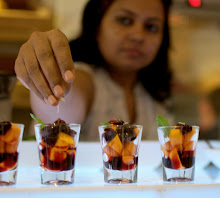Yesterday I decided to go for a morning walk cum bird watch walk with my friend Sukanya Dutta. She is an avid birder too and we started with our camera in hands at around 7 AM.
IARI campus at Pusa institute is a green place with huge old trees and a trained staff to maintain trees and the fauna around. We spotted many bird boxes hung over the trees for House Sparrows. But sadly there were no sparrows in sight, though we see few in our vicinity. The boxes were inhabited by Common Mynahs.
There is a favorite spot of mine in this campus, a huge Arjuna tree (
Terminalia arjuna) where we hear a loud noise always in the morning hours. To this date we used to think they were Vultures as the birds looked huge and their cry was harsh and reminded of Vultures. We could see the long necks and huge black birds to confirm our knowledge. The long straight beak was never noticed by the myopic eyes as we (me and my husband) never wore spectacles for morning walks. We have marginally myopic eyes by the way, which doesn't affect normal activities but to see a bird perched on a really tall tree is something else.
So I was wearing my spectacles, and we stopped as usual near the Arjuna tree to see the 'vultures'.
Sukanya is a popular Science writer with NISCAIR and has written 16 books including science fiction and children's books. She has been in this area for the last two decades and has always heard about the 'vultures' roosting in IARI. Yesterday this information was proven wrong.
So as we were looking at them, with bespectacled eyes, I told her these are not vultures for sure as the beaks are just too long. But she was backed by a two decade old knowledge and denied initially. And then I spotted the red head with the slightly powerful lens of my camera (18-105 mm). She was sure then that these were not vultures and kept wondering what could it be. It was a first time spotting of this bird for her as well.
She later confirmed, it was the Indian black Ibis.
This is how I clicked the first picture as in the past too I had always saw them sitting in the nests mostly in pairs. So naturally the camera was pointed towards a nest...
Long beaks evident...
And then one of them stooped his head. It was red. Red signal for us to look out for identifying the species.
And then I spotted a few loners...see the beak...
And the red head...
It raises it's head...
Moves the neck...fluffed up to scare us may be. Birds are always aware someone is watching.
And then smoothing the fluffy neck....if our goose bumps were so easy to hide :-)
Another one looking like an Ostrich...
This one showing it's red head....
And this one guarding the nest while the female is incubating the eggs ...
I noticed the nests looked as if tied with a light colored rope or something, to the branch it was located. See the light bands below the nest marked on the branch...
I was amazed how the birds could have done it. It was later when Sukanya called me up within an hour of returning for the walk, with excitement that she has searched and found what species it is. And when I reminded how the nests looks tied up with a rope she told it could be the bird droppings which trickles down. She knows better.
It was unbelievable though, as those bands looked so uniform... Later when I cropped my pictures, it was confirmed these markings were actually bird droppings.... See the next picture...
The liquid droppings have trickled down on the sloping branch...
See the next , where the bird sitting in the nest is watchful of us, the male on guard looks lazy and the dropping markings are clear...but looking like the branch has been wrapped with light colored rope or something....
Look at the markings more clearly...from below the tree we couldn't have imagined these were bird droppings. looked exactly like someone has tired up the nests for support..
The male guard has started preening...bored of his job of a watch guard ...
But he checks out the nest in between....
Another nest, another female sitting pretty ...
These two are looking like they lost something...
I was calling them redheads all this while...
It was only later that we knew the name thanks to the enthusiasm of Sukanya Dutta. I was having my cup of tea when she was searching the internet frantically...No wonder she is a scientist...
Look at the dropping markings again...
This bird made our day.
And this was not all we spotted yesterday. We found a nesting heaven for Yellow footed green pigeons. There were a few dozens of them perched on almost every branch of a Causuarina jungle of sorts...
A Drongo, a few Brown headed Barbets and a couple of Woodpeckers, some Grey Hornbills and many more.
It was a great walk indeed.


